The Italian Ferry Companies
The severe Depression of the early 1930s saw Italian shipping companies unable to pay back their loans to the Italian Commercial Bank. Benito Mussolini then set up in 1932 a new State owned holding company, Societa Finanziara Industriale Italiana, to take over the locked in shipping assets. State guaranteed bonds were issued to finance maritime holdings and these in turn financed the reshaped deep sea fleets of Italia Line and Lloyd Triestino, and the short sea and Mediterranean passenger fleets of Adriatica and Tirrenia.
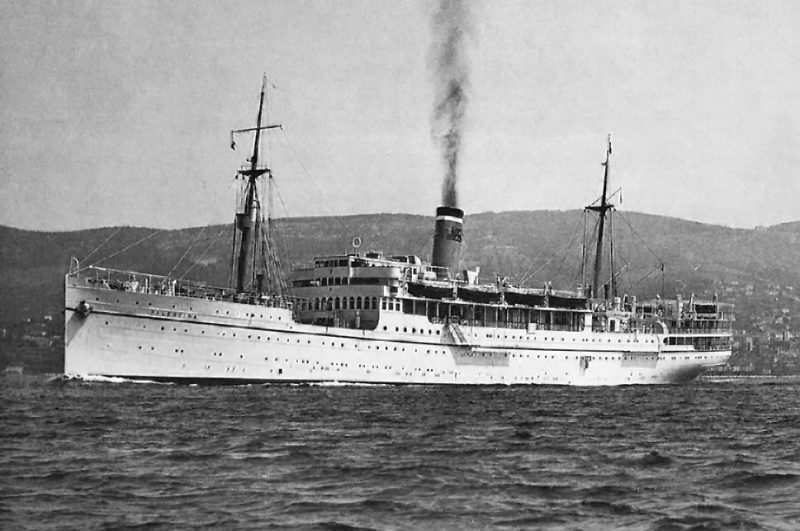
On 4th April 1932, a reshaped Societa per Azioni di Navigazione Adriatica (Adriatic Shipping Co. Ltd.) was formed in Venice, with this fleet increased in size by the takeover of several small private shipping companies including ‘Costeira’, ‘Nautica’, ‘Puglia’, ‘San Marco’ and ‘Zaratina’, and operating from the ports of Venice, Ancona, Bari and Brindisi to the Istrian Peninsula, Yugoslavia and Albania. ‘Fiumana’ joined in 1936 to complete the control of all Adriatic services. A new Societa per Azioni di Navigazione Tirrenia (Tirrenia Shipping Co. Ltd.) was formed on 17th December 1936, based in Naples, as a State owned entity following the nationalization of several private shipping companies, and principally the ‘Florio’ and ‘Citra’ (Compagnia Italiana Transatlantica) fleets.
Adriatica
Venice was founded in the year 421 on the islands of the Rivo Alto in the forty mile lagoon that today stretches from Chioggia in the south to Porto Marghera in the north. The city became one of the four Maritime Republics of Italy, the others being Genoa, Pisa (connected to the sea at that time), and Amalfi. The emblems of the four Maritime Republics are displayed today in the four quarters of the flag of the Italian Navy. The winged lion is the emblem of the city of Venice, and was very proudly displayed on the Adriatica funnels.
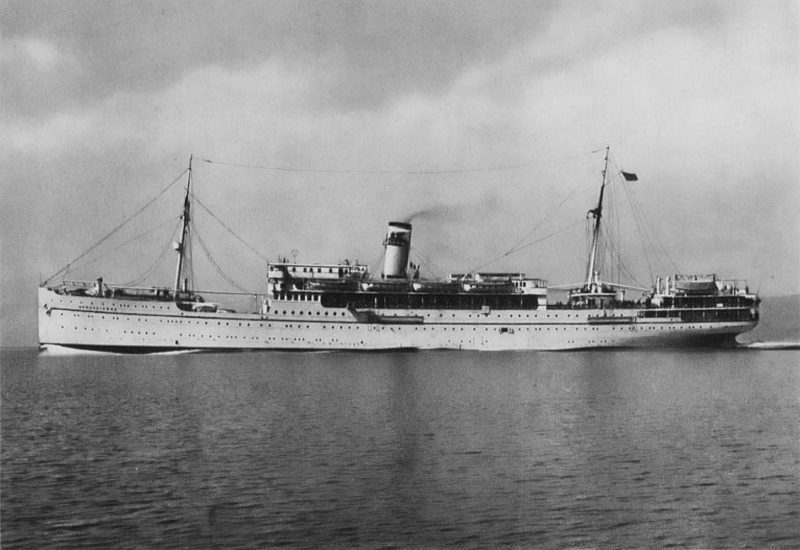
The remit of this Venice based company included all cross Adriatic Sea passenger and cargo services, as well as services to Greece, Turkey and the Eastern Mediterranean countries of Palestine and Egypt. Accordingly, five medium sized passenger liners of up to 11,400 grt were transferred from Lloyd Triestino to operate the Levant service. These were Esperia, Galilea, Gerusalemme, Marco Polo and Palestina, all built between 1912 and 1920. The coastal Adriatica services were operated by a fleet of twenty diesel powered vessels of between 1,975 grt and 3,400 grt, mostly twin screw and powered by two 6-cylinder Fiat diesels. These included Adriatico, Barletta, Brindisi, Brioni, Caldea, Calitea, Cilicia, Citta di Bari, Egeo, Egitto, Lero, Loredan, Narenta, Rodi and Zara, as well as several older steamers including Celio, Diana, Duino and Merano. In 1938, the fleet of the old ‘Adria’ shipping company was taken over, with a general cargo and fruit service from Italy and North African ports to North European ports. The Adriatica funnel colours in 1938 became deep yellow/ochre with thin red and white bands below a black top and carrying the Venezian winged bronze lion.
A large Adriatica fleet of 42 ships (24 motor, 18 steam powered) was owned when Italy entered World War II in the summer of 1940, but after three years of fighting, and a further two years when Germany carried on the fighting, the Italian merchant fleet had been almost totally devastated, with only 95 small Italian merchant ships still afloat in the summer of 1945. One notable exception in the Adriatica fleet was the passenger liner Gerusalemme, completed in 1920 as Cracovia for Lloyd Triestino and renamed Gerusalemme in 1934 and later transferred to Adriatica. She survived because, after the Italian surrender in June 1943, she was seized by the British Government and used as a hospital ship until returned to her owners in 1946. She then restarted the Levant service with accommodation for 440 passengers in three classes, and her four old steam turbines were still capable of 14 knots.
However, the Italian merchant fleet took a long time to rebuild itself after the war, as the shipyards were devastated and new construction was severely restricted by the Allies. The shipyards and factories were rebuilt, but the workforce lived a hand to mouth existence with inflation double that at the start of the war. An Italian seamen’s strike in 1949 inconvenienced thousands of passengers, but a new Adriatica passenger liner was eventually completed at Monfalcone in September 1949 named Esperia of 9,314 grt, with accommodation for 500 passengers in three classes to partner Gerusalemme on the Levant route. The cargo fleet was rebuilt using three American ‘Jeep’ types renamed Belluno, Rovigo and Treviso and four new cargo ships named Chioggia, Loredan, Udine and Vicenza. The fleet had been rebuilt to fifteen ships by 1950 for its many services, which was supplemented by chartered ships such as Valfiorita of Lloyd Mediterraneo spA, better known as Perth completed in 1920 by the Caledon yard at Dundee for the North Sea services of the Dundee, Perth and London Shipping Co. Ltd.
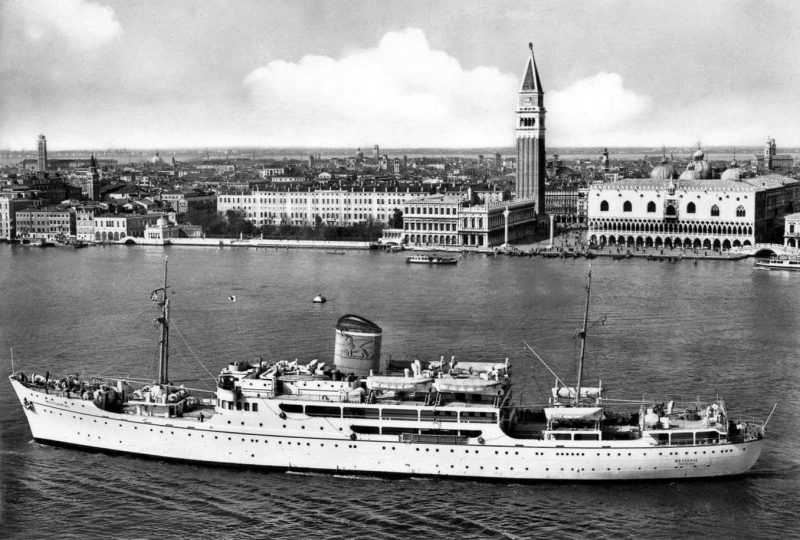
The Adriatica passenger and cargo ships Enotria and Messapia of 5,713 grt were completed in 1951/52 at Leghorn and Taranto respectively with accommodation for 282 passengers in three classes and could carry 2,250 tonnes of cargo. They gave 25 years of service to Adriatica on the long haul Venice to Alexandria route via Piraeus before they were sold to Cypriot owners and renamed Kowther and Zamzam respectively. Zamzam then gave more years of service to Orri Navigation Lines of Saudi Arablia. The Adriatica company had naturally very strong associations in Venice, notably the Palace of the Adriatic, which carried the emblem of the Marine Serenissima, the winged Venezian lion, and very large green winged lions were adorned on the funnels of Messapia and Enotria.
The next two passenger and cargo ships were named San Marco and San Giorgio after the great basilicas of San Marco and San Giorgio Maggiore in Venice. These stylish white hulled vessels were completed at the Trieste yard of Cantieri Riuniti del Adriatico and were of 4,755 grt with accommodation for 274 passengers and could carry 1,476 tonnes of cargo. They also carried very large, embossed Venezian golden winged lions on their ochre funnels beneath narrow white and red bands and a black top. They operated the Adriatic to Istanbul service and were the first Italian ships to be fitted with Denny-Brown stabilizers.
San Marco and San Giorgio had swept back ‘swan’ bows, streamlined accommodation and two raked bipod masts carrying ten derricks. The numbers of passengers in first and second class could be varied, with 98 passengers carried in third class. They had four holds, two forward and two aft, and numbers 1 and 4 holds were fitted with ‘tween decks. Their service speed was 17 knots from twin 7-cylinder C.R.D.A. Fiat diesels direct coupled to twin screws. They were eminently suitable for conversion to cruise ships after twenty years of Adriatic service in 1976/77. San Marco became City of Mykonos for Cycladic Cruises and owned by Kyriakos, but sank at Eleusis in 1994 and was refloated and was still laid up there in 2005. San Giorgio became City of Andros for Cycladic Cruises, and then Ocean Islander in 1984 and Royal Star in 1990 of African Safari Cruises and was laid up in 2009.
The much loved Ausonia of 11,879 grt was launched on 5th August 1956 and completed on 23rd September 1957 by the Monfalcone yard of Cantieri Riuniti del Adriatico. She operated the Trieste to Egypt and Lebanon service calling at Venice, Brindisi, Alexandria, Beirut, Piraeus and Bari before returning to Trieste. She had accommodation for 181 passengers in First class, 118 in Second class, and 230 in Third class, with a crew of 215, and could also carry 3,000 tonnes of cargo. Her twin Parsons geared steam turbines of 22,400 shp were manufactured at Trieste and gave her a service speed of 21 knots and a maximum speed of 23 knots. Adriatica sold her in 1979 for conversion for cruising by Arsenale Triestino for Italia Crociere International and she remained under the Italian flag for the Grimaldi-SIOSA Group until sold to Louis Cruises of Cyprus in 1998. She now carried 690 cruise passengers and was chartered to First Choice for cruising out of Southampton in 2001. In 2005, she was renamed Ivory and then Aegean Two in 2007 for Aegean cruising, but time had caught up with this grand old lady with the 2010 SOLAS regulations and she arrived in Alang in India for scrapping in March 2010.
The national celebrations in 1961 to mark the centenary of the unification of Italy saw the Adriatic fleet with twenty passenger and cargo ships including the new sisters Brennero, Bernina and Stelvio of 4,350 grt with accommodation for 81 passengers. The much bigger Appia of 8,017 grt with a service speed of 17 knots and accommodation for 1,130 passengers was the first drive-on drive-off Adriatica ferry and operated the route from Brindisi to Corfu, Igoumenitsa and Patras alongside the French built Greek owned Egnatia owned by Hellenic Mediterranean Lines (HML). Appia had the ochre hull livery that was subsequently adopted by most Adriatica vessels to match their funnel colours, and was retired in 1991 and sold in 1992 and renamed Fibi, and was then broken up at Alang in India in 2005. The capacity on the Brindisi to Patras route had doubled by then with the introduction of Castalia of HML and Espresso Grecia of Adriatica. The passenger vessel Illiria of 3,851 grt had followed in 1962, and Palladio of 3,630 grt in 1963, and the small cargo only Daunia of 822 grt in 1965.
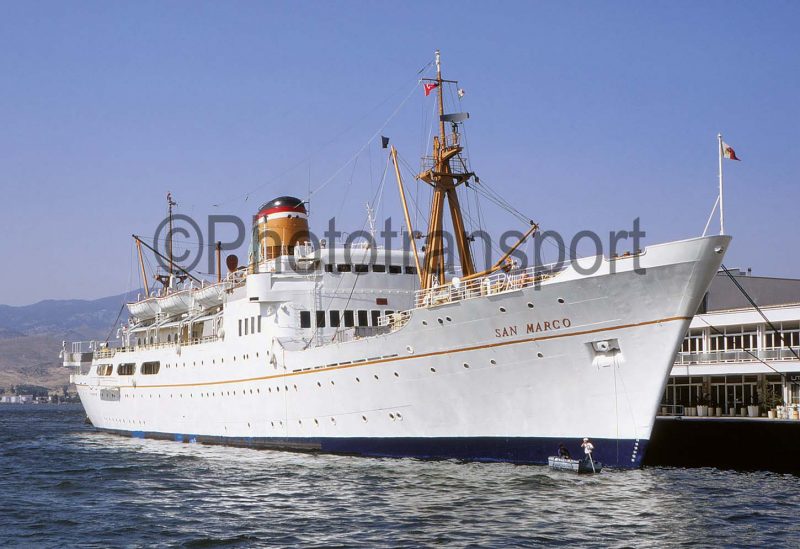
Adriatica freight ro-ros began operating in 1969 from Trieste, Venice and Brindisi to Piraeus, Beirut, Famagusta, Latakia and Izmir. New ro-ros included Corriere del Nord, Corriere del Sud, Corriere dell’ Ouest, Corriere dell’ Est, Piedmont Express, Allemagna Express, Anglia Express, Fenicia Express, Levante Express and Serenissima Express, Espresso Ravenna and Espresso Venezia. The passenger/ro-ro fleet was then updated in 1980 for the Adriatic routes of Pescara to Split, Ancona to Zadar, and Bari to Split and Dubrovnik with the purchased Tiepolo (ex Canguro Bianco), Tintoretto (ex Jacopo Tintoretto) and Tiziano from other Italian owners. Tiepolo was sold in 1993 and broken up at Alang in 2004, and Tintoretto was sold in 1989 and broken up at Aliaga in 2002, while Tiziano was sold in 1993 and is still in service with other owners.
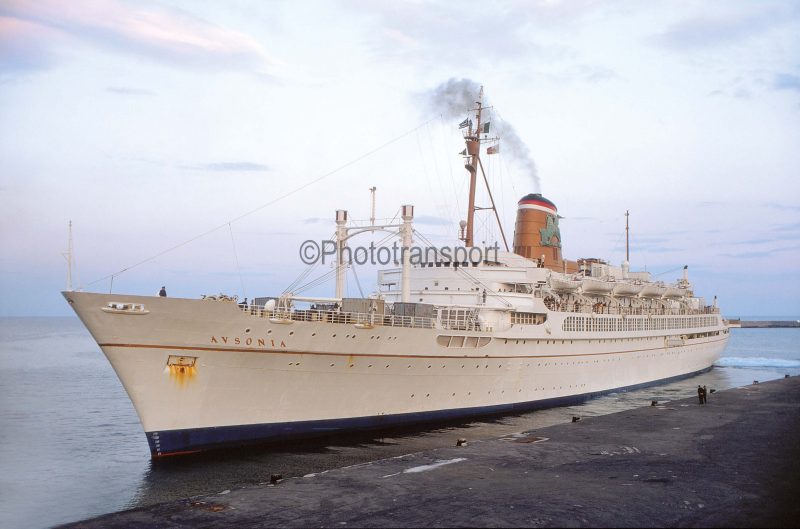
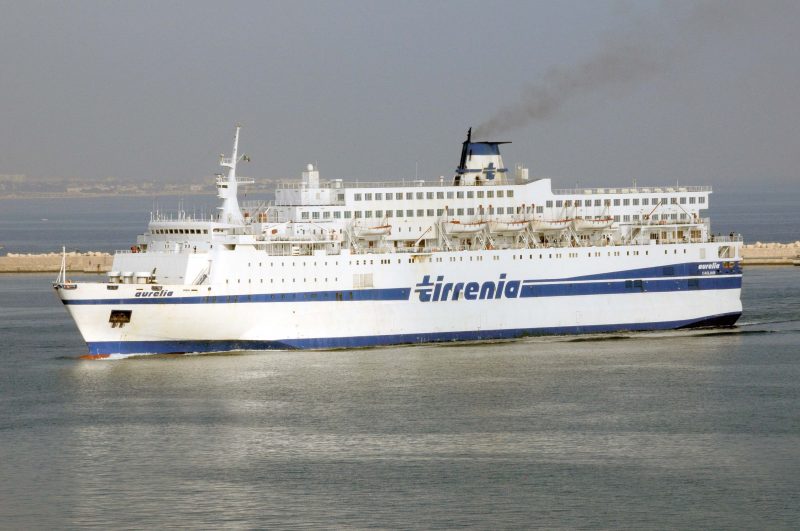
The Lloyd Triestino passenger liner Victoria of 11,695 grt was the largest Adriatica ship until the advent of two Tirrenia ships, Domiziana and Flaminia, transferred in 2004 to the Adriatic. Victoria was one of seven sisters completed during 1951/53 for the deep sea services of Lloyd Triestino, with Victoria and Asia employed on the Far East route, and Australia, Oceania and Neptunia employed on the Australian route, and Africa and Europa employed on the East African route. They were fast 20 knot motorships completed at Monfalcone and Trieste, and Victoria and Asia returned to Trieste in October 1973 when their Far East service ended. Victoria was then refitted at Trieste and transferred to Adriatica on the route from Trieste to Beirut. She also went cruising to North Africa, Morocco and the Canaries until June 1977, when she was laid up at Venice. She was towed from Venice to Piraeus in July 1979 for conversion to the hospital ship Anastasis for Mercy Ships. She served in this capacity in West Africa saving many thousands of lives from 1982 until broken up in 2009.
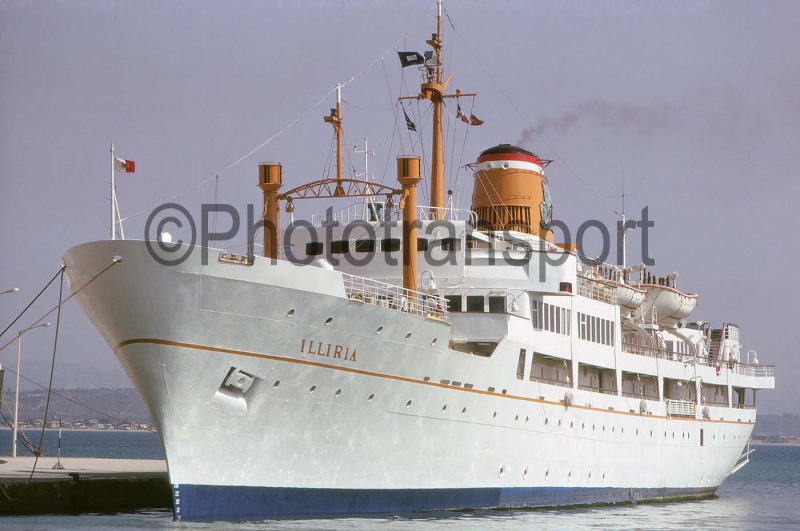
After the sale of Ausonia and Victoria in 1979, the passenger route between Venice and Alexandria via Piraeus was operated by Espresso Egitto of 8,975 grt. She had been completed in 1974 and was purchased in 1980, and had cabin capacity for 576 berthed passengers in cabins for this long haul route. In 1986, the Adriatica fleet had six passenger ferries, with Appia and Espresso Grecia on the Brindisi to Corfu and Patras route, Espresso Egitto on the Venice to Alexandria route via Piraeus, Tiepolo on the Ancona to Zadar route, and Tintoretto and Tiziano also sailing from Ancona, Bari and Brindisi to Yugoslavian ports.
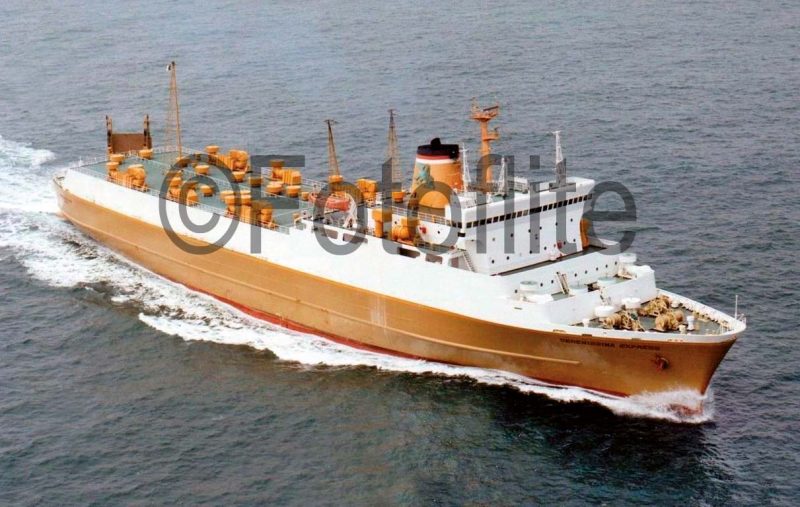
Adriatica freight ro-ros Serenissima Express, and Anglia Express were transferred to Tirrenia in 1988 after refit. They were replaced during the 1990s by Buona Speranza, Egizia, Fenicia and New Ventura. A trio of new twin funnelled passenger and freight ro-ros entered service during 1989/92 on the route to Greece named Laurana, Palladio and Sansovino of 10,977 grt. This trio had been built at Ancona and Palermo and had accommodation for 342 berthed passengers, 752 deck passengers and 276 cars or equivalent lorries and trailers and service speeds of 15 knots from twin Fiat diesels.
The ‘Viamare’ strategy of using fast freight ro-ros on the important North to South Italian routes to ease motorway congestion began to be implemented in 1992 by the Finmare Group with the completion of five large ro-ros, (four in Holland), named Via Adriatico, Via Ionio, Via Ligure, Via Mediterraneo and Via Tirreno. They are twin screw ships with a service speed of 19 knots and a lane length of 1,650 metres and accommodation for one hundred berthed lorry drivers. Two have been operated by Tirrenia, and two by Adriatica, with the Adriatica pair then renamed as Espresso Ravenna (ex Via Ionio) and Espresso Catania (ex Via Mediterraneo) for a North to South freight service from Ravenna on the Adriatic to Catania in Sicily. This important initiative to relieve serious Italian road congestion particularly from Naples to Messina has since been successfully increased in scale in the Mediterranean by private shipping companies such as the Grimaldi Group and others.
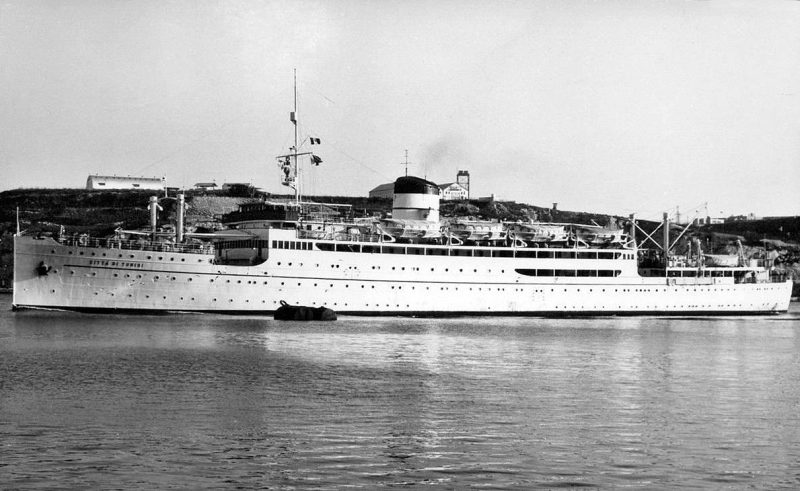
At the Millennium, a fleet of nineteen passenger, freight ro-ros, fast hydrofoils and small ferries was being operated by Adriatica. The conventional passenger ferries were Egitto Express of 1973, Espresso Grecia of 1973, Espresso Venezia of 1978, and the largest passenger and freight ro-ros were Laurana, Palladio and Sansovino. In November, 2004, this fleet became a division of the Tirrenia fleet, and two Tirrenia passenger vessels, Domiziana and Flaminia, were transferred to the Adriatic service from Bari to Durres in Albania. The new Adriatica Tirrenia Navigazione ships have white hulls with ‘Tirrenia’ in bold letters and ‘Adriatica’ beneath in small letters on both sides of their hulls. One very interesting service is to the tiny Tremiti Islands to the north of the Gargano peninsula, and is operated by the fast ferry Isola di Capraia of 577 grt, named after one of the islands, and can carry 522 passengers at a speed of 27 knots. The islands were formerly used as convict prisons for political and violent offenders, but today there is a steady flow of summer tourists who come for the much happier reason of a summer holiday on uncrowded beaches.

Tirrenia
Tirrenia is today one of the largest ferry companies in Europe, transporting twelve million passengers, two million cars and seven million lane metres of freight per year. Its remit covers all trans Tyrrhenian Sea passenger and freight services to Sardinia, Sicily, and the smaller Italian islands as well as trans Mediterranean services to North Africa. After its formation on 21st December 1936, seven larger passenger liners from the Transatlantic fleet of the ‘Citra’ company were not required and were accordingly transferred to Lloyd Triestino.
The many coastal passenger services were operated by thirteen coastal vessels, all completed in 1929/30 for the ‘Florio’ company, the other main constituent alongside the ‘Citra’ company. Nine were diesel powered sisters of 2,500 grt with accommodation for one hundred passengers and named Citta di Agrigento, Citta di Alessandria, Citta di Bastia, Citta di Livorno, Citta di Marsala, Citta di Messina, Citta di Savona, Citta di Spezia and Citta di Trapani. This group of nine were single screw and were powered by 6-cylinder Tosi diesels manufactured at Legnano to give a service speed of 12 knots. The longer routes to Sicily and North Africa were operated by a quartet of larger diesel powered sisters of 5,400 grt with accommodation for 500 passengers and were named Citta di Genova, Citta di Napoli, Citta di Palermo and Citta di Tunisi. This quartet was twin screw and powered by twin 6-cylinder diesels manufactured at Legnano to give a service speed of 17 knots.
The initial fleet also included some older steam passenger vessels of up to 4,600 grt including Citta di Bengasi, Citta di Catania, Citta di Trieste and Citta di Tripoli. The two largest steamers were the twin funnelled Garibaldi of 5,278 grt, built in 1906 as Virginia by Societa Esercizio Basini at Riva Trigoso for Lloyd Italiano for services to North and South America, and she was renamed Garibaldi in 1911 by Ligure Brasiliana of Genoa and came to Tirrenia from the ‘Citra’ company. She was powered by twin steam triple expansion engines with a service speed of 14 knots, but unfortunately was partially sunk at Civitavecchia in 1943, and after being raised became a total loss at Genoa a year later. The other big steamer was Argentina of 5,526 grt built at Port Glasgow by Russell & Company for Cosulich of Trieste and came to Tirrenia in 1932 from the ‘Florio’ company. This pair of bigger steamers sailed from Genoa through the Suez Canal to the Italian Red Sea port of Massowa and on to Zanzibar. Remarkably, Argentina survived World War II, and continued sailing for Tirrenia until broken up in 1960.

Along with the Adriatica fleet, the Tirrenia fleet of 45 ships (22 motor, 23 steam powered) had been almost completely destroyed by the summer of 1945. Six old passenger vessels with ‘Citta’ names were reconditioned for post war service. The old ‘Adria’ fleet cargo vessel Verdi of 2,423 grt was purchased in 1948 and renamed Celio to operate alongside war built vessels such as Cagliari and Giosue Borsi, both of 4,325 grt, on the cargo services. A motor vessel of 830 grt with some passenger capacity was also purchased in 1948 from other Italian owners and renamed Olbia.
Tirrenia di Navegazione spA kept its leading position on the Tyrrhenian Sea in the late 1940s with the refurbished Ichnusa, Limbara, Torres, Rossini renamed Citta di Messina, Verdi renamed Citta di Cagliari, Alfredo Oriani renamed Celio, and Citta di Savona renamed Citta di Lovorno. Two new motor passenger vessels of 3,000 grt were commissioned as Citta di Catania and Citta di Siracusa in 1949 with accommodation for 125 passengers and could also carry 2,000 tonnes of cargo. In 1952, the route to Benghazi was restored by the Citta di Trapani, and to Spain by the Citta di Alessandria and Citta di Messina. The post war new Tirrenia passenger fleet from 1952 can best be described in the classes that have been built over the years as follows. All of these classes were stabilized and air conditioned, and equipped with modern navigational equipment and bow and stern thrusters.
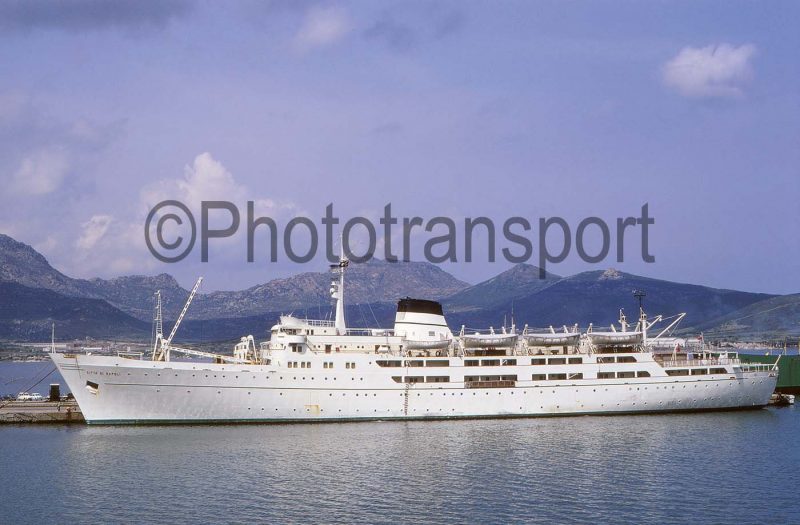
‘Regione’ class of five vessels named after the regions of Sicilia, Calabria, Sardegna, Campania Felix and Lazio and completed in 1952/53. The class gave up to 36 years of continuous service to the company. They were good looking passenger ferries of 5,230 grt with accommodation for 560 passengers, a figure that was increased with deck passengers when three of the class were converted to ro-ros with side and stern doors in 1968. Three were constructed at the Palermo yard of Cantieri Navali Riuniti, and two by the Castellammare yard of Cantieri Navali Navalmeccania, and the quintet were powered by twin Fiat diesels to give a service speed of 17 knots. Calabria served until laid up at Palermo at the end of the 1985 season, with her sisters lasting only one or two more summer seasons.
‘Sociale’ class with a trio named Arborea, Caralia and Torres of 5,485 grt in 1957 built at the Ancona and Castellammare di Stabia yards with accommodation for over 600 passengers (75 First Class, 400 Second Class, 172 Third Class). They were powered by Fiat diesels to give a service speed of 17.5 knots on the Genoa to Porto Torres route in Sardinia.
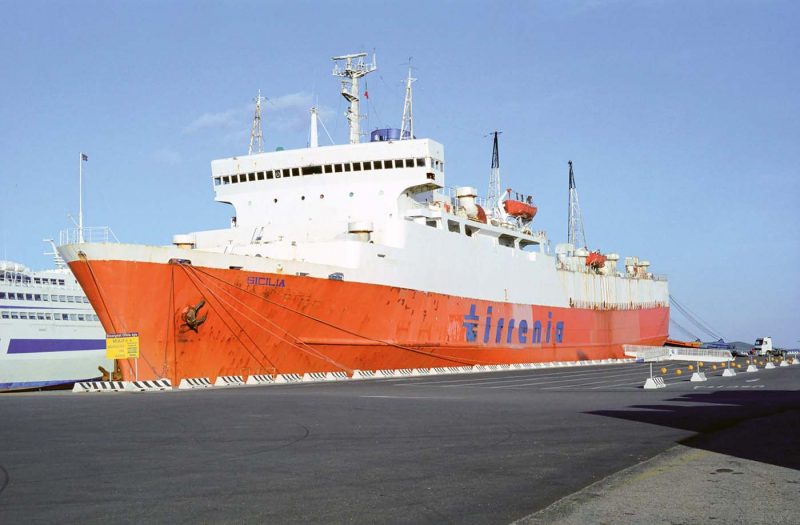
‘Citta’ class. A pair of sister passenger and car ferries of 5,735 grt were constructed in 1962 as Citta di Napoli and Citta di Nuoro at the Ancona and Castellammare di Stabia yards with accommodation for 313 First class and 642 Second class passengers with a small garage for 30 cars, and they were powered by Fiat diesels to give a service speed of 19.5 knots. The smaller and similar Malta Express of 4,164 grt built in 1968 made interesting runs for her 1,200 deck and 125 berthed passengers between Naples, Reggio di Calabria, Catania, Syracuse and Malta.
‘Poeta’ class of eight 22 knot passenger and ro-ro ferries were very important for Tirrenia in 1970/71, as five of this class were in service for almost thirty years until the advent of high speed ‘super’ ferries. Initially, a class of six vessels named after writers entered service as Boccaccio (completed first on 8th June 1970), Carducci, Leopardi, Manzoni, Petrarca and Pascoli, with a further two units following in 1978 named Deledda and Verga. They were used on the longer routes to Sardinia, Sicily, Tunisia and the island nation of Malta. They had accommodation for 1,000 passengers in 3 classes together with 125 cars or trailers. This proved insufficient to meet the growing need for passengers taking their cars on holiday, and five of the class were rebuilt in 1990, with four decks added to give a bizarre and top heavy appearance. Boccaccio, Carducci, Manzoni, Petrarca and Pascoli had their gross tonnage increased from 6,900 to 11,779, and this quintet continued in service until sold in 1999. This technique of adding several more decks as well as side sponsons is not unique to Tirrenia, as P. & O. Ferries of the U.K. also gave the same treatment to some of their English Channel and North Sea ferries. Some of the sextet were sold for service in the Red Sea, and Boccaccio unfortunately capsized on 3rd February 2006 while on a voyage from Duba (Saudi Arabia) to Safaga in Egypt with the loss of 1,012 passengers and crew under the name of Al Salam Boccaccio.
‘Staffetta’ class. Tirrenia passenger numbers in 1970 topped the two million mark with just over 200,000 cars also carried as well as half a million tons of freight. This freight traffic increased much further with the advent of the ‘Staffetta’ class of fast 20 knot ro-ros including Staffetta Adriatica, Staffetta Jonica, Staffetta Ligure, Staffetta Mediterranea, and Staffetta Tirrenica. However, very radical surgery in 1987 to reconstruct Staffetta Ligure, Staffetta Mediterranea and Staffetta Jonica as passenger and freight ro-ros was carried out, and they were renamed as a new ‘Sociale’ class of Arborea, Caralis, and Torres. Their built up stern superstructures then had accommodation for 1,200 passengers and they were still capable of carrying over 400 cars. Four other freight ro-ros were completed in 1976 to capture a greater share of the market for the nationalized fleet.
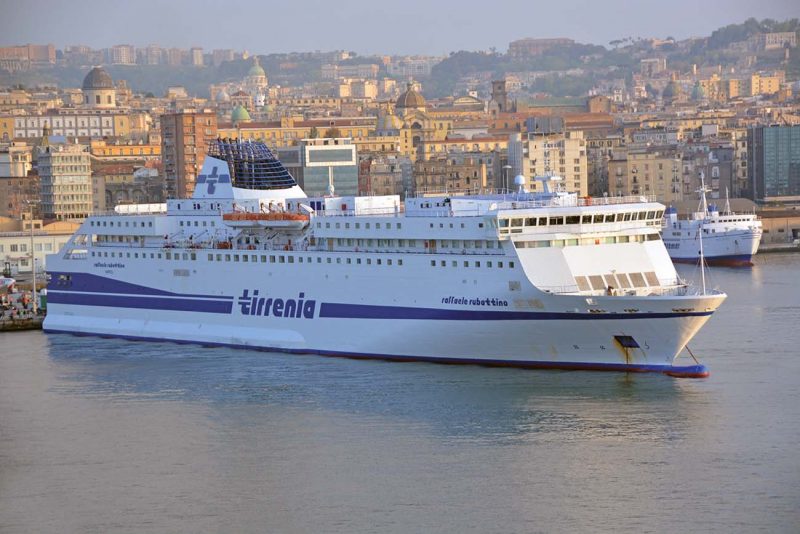
‘Espresso’ class built in 1977/78 as Ravenna and Venezia of 4,810 grt with accommodation for 141 First Class passengers, 254 in Second Class, and seats for 178. As day ferries, their total passenger capacity is eight hundred.
‘Strade Romane’ class. A class of six handsome passenger and ro-ro ferries was completed during 1978/81 as Aurelia, Clodia, Domiziana, Emilia, Flaminia and Nomentana at Castellammare di Stabia. The ‘Strade Romane’ class, named after Roman roads, was lengthened in 1987 to increase their accommodation to 568 berthed passengers and 1,400 deck passengers as well as 470 cars. Aurelia, the first of the class, underwent radical surgery in 2003 with three extra decks added in a similar manner to the ‘Poeta’ class, and this was also carried out to her sisters Clodia and Nomentana in 2003, both of which were broken up in 2013. This trio had 295 First class cabins with all of ‘Lounge’ Deck devoted to public rooms, and carry in total 2,280 passengers and 645 cars at a service speed of 18.5 knots. The unconverted Domiziana and Flaminia were subsequently transferred to the Adriatica division of Tirrenia in 2004, and in my opinion are the best looking of the class in their blue and white smart hull liveries and funnels.
‘Fastcraft’. The 3,500 grt Guizzo and Scatto of the Rodriguez Aquastrada type were followed by the very streamlined and fast 40 knot ‘Jupiter’ class of Aries, Capricorn, Scorpio and Taurus. They were completed in 1998 at the Riva Trigoso yard as the Fincantieri MDV3000 type to reduce voyage times and boost passenger numbers on the main routes. They had swept back superstructures, funnels placed right aft above two stern door/ramps and sharply angled bows. They were powered by quadruple screw gas turbines connected to water jets, and carry 1,800 passengers and 460 cars. Their lengths were 145.6 metres and their gross tonnages are 11,347, with Second class passengers on a deck below First class passengers, and above both of these decks was a very comfortable lounge bar fitted out with modern seating and interior decoration. However, the quartet suffered from rising fuel costs but did connect almost every Italian island. They were withdrawn from their service in 2009 from the Naples to Palermo and Sardinia route.
Tirrenia Ro-Ro Fleet
In 1974, the Italy to North European route with three cargo vessels in Cagliari, Giosue Borsi and Vallisareo was transferred to Adriatica. Tirrenia had a fleet of 32 ships by the mid 1980s, with twenty passenger ferries in operation on the longer runs from Genoa, Livorno, Naples and Civitavecchia to the Sardinian ports of Olbia, Porto Torres, Cagliari and Arbatax. Several were under refit in the winter off season, six were small short run ferries, and six were freight ro-ros. The ro-ro freight fleet had been updated with Julia (renamed Campania), Apulia, Torre del Greco and Adria, and later by two freight ro-ros transferred from Adriatica and renamed Calabria (ex Serenissima Express) and Sicilia (ex Anglia Express). They were withdrawn in 2006 after giving 30 years of excellent service. Three other ro-ros completed in 1981 at Ancona and Genoa were widened and converted into the ‘Capo’ class of passenger and freight ro-ros in 1988 named Capo Carbonara, Capo Sandalo and Capo Spartivento with accommodation for 760 berthed passengers, 750 deck passengers and 340 cars. The freight ro-ro Toscana was completed in 1994 by the Cantieri Visentini yard at Donada, and was converted into a passenger and freight ro-ro in 1997 by rebuilding her stern, and has been refurbished in the Summer of 2006 to carry 600 passengers and 300 cars at a speed of 19 knots.
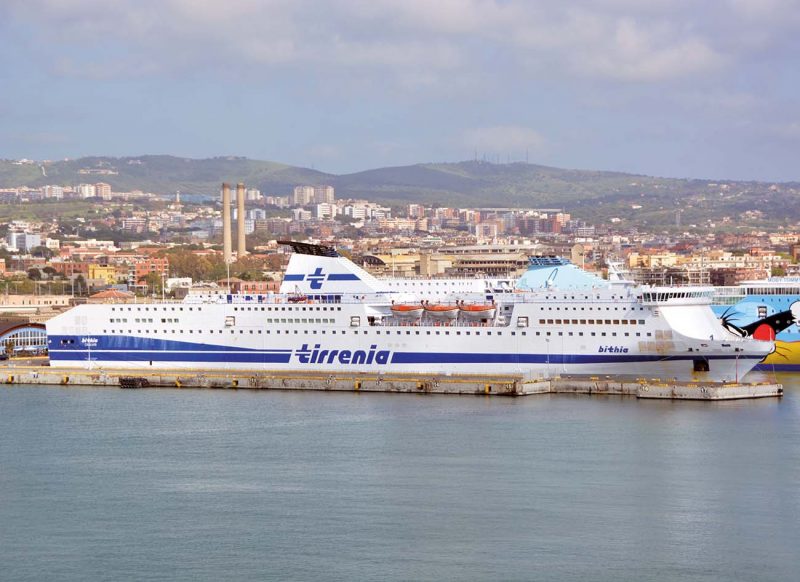
Two new freight ro-ros were completed at Palermo in 1994/95 as Lazio and Puglia, sisters of the ‘Viamare’ quintet incorporated from the Viamare company, with lane lengths of 1,850 metres and accommodation for one hundred lorry drivers, and along with all Tirrenia freight ro-ros have orange hulls with ‘Tirrenia’ in blue on the sides. The local Sardinian coastal services have been served by a number of very small ro-ro ferries of 494 grt constructed during a twenty year period from 1966 to 1986 and carrying 336 day tourists and ten cars. The class included Arbatax, Carloforte, Limbara, Ichnusa, La Maddalena (named after a beautiful archipelago of islands to the north of Olbia), and Teulada. In 1998, Tirrenia owned 16 passenger ferries and five freight only ro-ros, with two of the latter being the Nuevo Regione class completed at Shimonoseki for Adriatica and refitted in 1988 and transferred to Tirrenia.
Tirrenia ‘Super’ Ferries
The present Tirrenia passenger fleet has nine very modern and fast ‘super’ ferries built since 1999 for the routes to Sardinia and Sicily. The first pair entered service to Sicily in 1999 as Vincenzo Florio and Raffaele Rubattino on the Naples to Palermo main route. They are named after members of the Florio family of Palermo and the Rubattino family of Genoa, who were born in the first decade of the 19th century and formed the first unified Italian shipping company in 1881, Navegazione Generale Italiana (NGI), and a major constituent of the later Italia Line of 1932. They have accommodation for 1,471 passengers and can carry 626 cars on their car decks and were constructed at La Spezia. They have stylish public rooms including two restaurants, two bars, shopping malls and a cinema, and have service speeds of 23 knots from twin Wartsila 12-cylinder diesel engines producing 32,628 bhp. They have elegant double and quadruple cabins for overnight voyages, and their gross tonnage is 30,757 and they have a length of 180.3 metres.

fleet.
Fire broke out on Vincenzo Florio in the early hours of 29th May 2009 as she neared the end of her regular run from Naples to Palermo. She was only 25 miles from port when a car burst into flames, with the entire car deck soon a raging inferno and clouds of smoke billowing out from the vessel. All of her 526 passengers and some of her crew took to the lifeboats, with the vessel towed into port by three tugs, where shore firefighters then entered the car deck and quelled the blaze. The ferry was subsequently repaired and re-entered service.
A class of five further big passenger sisters has also entered service as Bithia in the summer of 2001, Janas in early 2002, Athara in the summer of 2003, Nuraghes in the summer of 2004, and Sharden in early 2005. They have been given traditional Sardinian names to boost the passenger numbers on this main route. Their length is 214.6 metres, with a breadth of 26.4 metres, and can carry between 2,700 and 3,000 passengers and between 900 and 1,085 cars. They were built by FCNI (Fincantieri Cantieri Navali Italiana) at Castellammare di Stabia and are powered by twin Wartsila diesels of 69,828 bhp to give a fast service speed of 30 knots. They have twin stern doors and ramps for fast loading and discharge of cars and lorries, and their gross tonnages are between 36,000 and 40,000 and have raised the standard of Tirrenia passenger ferries to combat the competition of similar ferries operated by Moby Lines and SNAV on the same routes. Nuraghes and Sharden have been fitted with an extra car deck to increase capacity over their three earlier sisters.
Two high speed passenger ferries were leased from Minoan Lines of Greece in July 2012 for five years and renamed Amsicora ex Europa Palace and Bonaria ex Olympia Palace. They were completed in 2001/02 for the Greece to Italy service and are of 36,825 grt with accommodation for 1,922 and a car deck for 730 cars. They feature a good restaurant, three bars, a cinema, a play room for children and a conference room for business use. They run on the main Civitavecchia to Cagliari route where their top speed of 29.5 knots can compete with high speed craft.
The latest Tirrenia ro-pax vessel is Dimonios of 26,500 grt completed in 2007 with accommodation for 800 passengers and 2,225 lane metres of car deck for cars and lorries on the Naples to Cagliari and Cagliari to Palermo routes, and after a refit in 2013 also on the Cagliari to Trapani route. The other ro-paxes in the current fleet are Puglia, Via Adriatico, Espresso Catania and Espresso Ravenna with accommodation for 75 lorry drivers and their lorries on car decks of lane length 1,650 metres. The high speed ferry Isola di Capraia of 1,950 grt is used for the Tremiti Islands service in the Adriatic with a top speed of 27.5 knots and seats for 522 passengers and a small car deck for 57 cars. The older ‘Strade Romane’ ferry Aurelia built in 1980 is in reserve and is sometimes used for humanitarian missions and other charters.

fleet.
The main Tirrenia routes are Genoa to Porto Torres, Olbia, Arbatax, and Cagliari, Civitavecchia to Olbia, Arbatax, and Cagliari, Naples to Cagliari and Palermo; and Cagliari to Palermo and Trapani, and a freight only service from Ravenna to Catania. Trapani was the landing port for Peter of Aragon in 1282 to start the Spanish occupation of Sicily. Typical voyage times are five hours from Naples to Cagliari and a similar length of time from Naples to Palermo. Tirrenia also operates a summer service from Naples to Messina for passengers and cars. The Tirrenia owned Siremar (Sicilia Regionale Marittima) was privatized in 2011 and now serves the islands of Eolie, Egadi, Pelagie, Ustica, Lampedusa, Linosa and Pantelleria from Sicily as an independent company. The small ferry companies serving the minor islands in the Campania, Sardinia and Toscana regions also passed into the control of their respective regions in November 2009.
An attempt to privatize the debt laden Tirrenia company in 2010 ended on 28th July when the bid of €25 Million by Mediterranea Holdings was rejected. Tirrenia remained State owned by Fintecna, the Ministry of Infrastructure and Transport, but filed for bankruptcy on 23rd September 2010 to afford temporary protection. An improved offer was made in November, 2010 by a consortium of Moby Lines, Grimaldi group and MSC container line. This was turned down, but eventually an offer of take-over for Tirrenia plus its €72 million per year State subsidies by Compagnia Italiana di Navigazione (CIN) was referred to a monopoly position investigation in 2012, which reported in favour of the offer. CIN became the owner of Tirrenia on 19th July 2012, with Vicenzo Onorato, owner of Moby Line, as the biggest shareholder in CIN with a 40% stake.
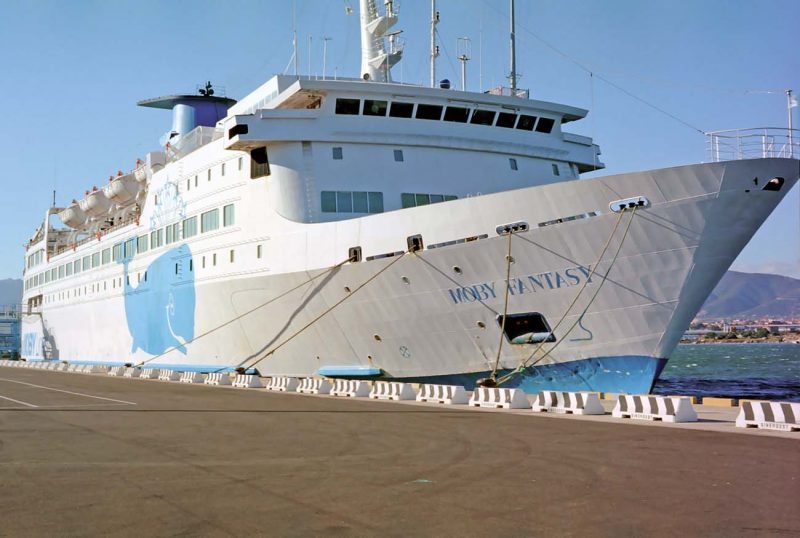
Postscript
The Tirrenia Headquarters has been since 1937, until recently, in the spectacularly grand setting of the Palazzo Sirignano, beloved of all Neapolitans. It stands to the west of Castel dell’ Ovo on the waterfront, on the Riviera di Chiaia, which has been the preferred dwelling place of noble Neapolitan families since the 18th century, although the building is actually much older, dating from 1535. This architecturally very important three storey building faces the sea and features Neo-Renaissance style frescos, staircases, sumptuous wood inlays, Renaissance furniture gems and other objets d’artes in the dining room and public rooms. This building is open to the public on every third Sunday of each month (excluding August) between 10 am and 1 pm and is well worth a visit when in Naples. In December 2014, CIN Tirrenia moved from this historic building to Calata Porta di Massa, Interno Porto.
Italian State Railways (Ferrovie dello Stato or FS) have operated passenger and rail ferries across the Straits of Messina from Villa San Goivanni in Reggio Calabria to Messina in Sicily and from Civitavecchia to Golfo Aranci on Sardinia for many years. Golfo Aranci is a few miles down the gulf from Olbia and is a port, straggling resort and fishing port, all rolled into one. There were fifteen passenger and train ferries in 1975 including Messina 1,412/23 with accommodation for 650 passengers, 27 lorries and eight rail carriages. On 1st July 2001, Rete Ferroviaria Italiana (RFI) was formed as the marine rail subsidiary of Italian State Railways, and today the name of Messina is proudly taken by a twin funnelled train ferry.
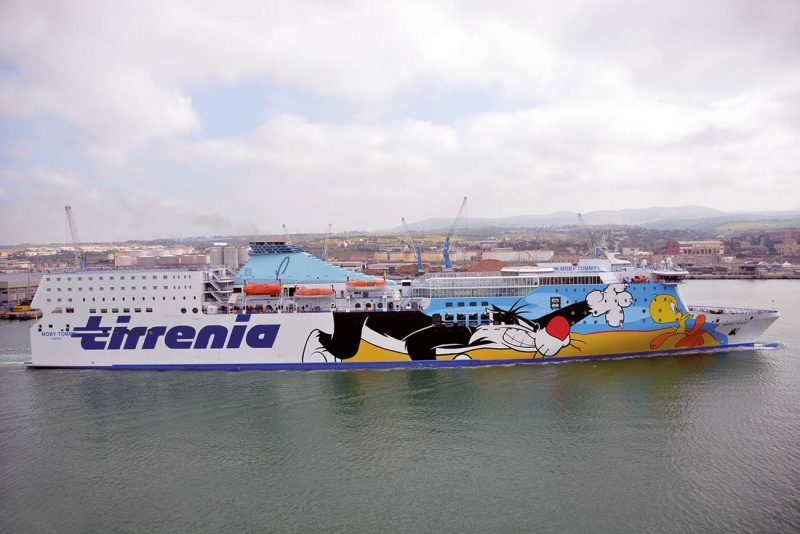
The Bay of Naples ferries to the islands of Capri, Ischia, and Procida are today run by AliLauro, founded in 1944 by Agostino Lauro of the famous Neapolitan family of shipowners. A fleet of twenty fast ferries, hydrofoils and water jet ferries each carry up to four hundred passengers at speeds of 32 knots. Almost half of the fleet are named after members of the Lauro family, but other important Bay ferries have included the former Norwegian ferry Isefjord, and the Denny built Royal Sovereign of 1948 from the Eagle Steamers fleet of the General Steam Navigation Co. Ltd. She was renamed Ischia in 1974 and later heavily modified in appearance, serving until she sailed from Naples to the scrapyard at Aliaga in Turkey in December 2007 and was then broken up in 2008 after a sixty year career.
A further attempt to merge the Moby Line fleet of twenty ferries with the equally big Tirrenia fleet was approved in early July 2015 to give a virtual monopoly on services from the Italian mainland to Sardinia, but seven months later the plan was put on hold. Vicenzo Onorato, owner of Moby Line and 40% owner of CIN Tirrenia, attempted to purchase all of the remaining shares in the hands of private shareholders, but this was again refused by the Tirrenia CIN shareholders as unacceptable on 10th February 2016. Moby Line ‘Super’ ferries today include the colourful hull graphics ferries Moby Aki, Moby Ale, Moby Baby, Moby Baby Two, Moby Corse, Moby Dada, Moby Drea, Moby Kiss, Moby Love, Moby Niki, Moby Otta, Moby Tommy, Moby Vincent, Moby Wonder and Moby Zaza.

Tirrenia funnel colours were originally white with a thin black band and a black top, but today they are white with a central blue band bearing the Tirrenia logo. There will come a point in time in future when Moby Lines secures control of CIN Tirrenia, as all three of the Tyrrhenian ferry fleets of Tirrenia, Moby Lines and SNAV were fighting for survival and customers as recently as 2009. SNAV (Societa Navigazione Alta Velocita) has fourteen high speed ferries, five hydrofoils and five ro-ros for the routes from Naples to Palermo, the Aeolian and Pontine Islands.
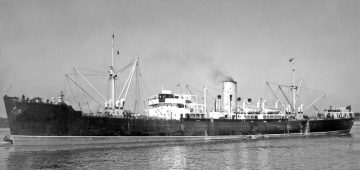
Comments
Sorry, comments are closed for this item